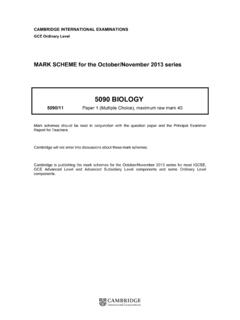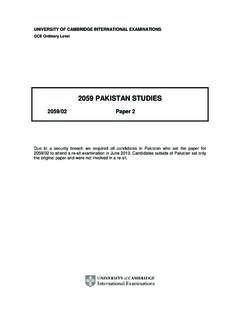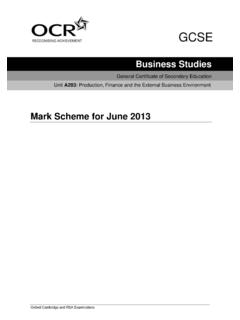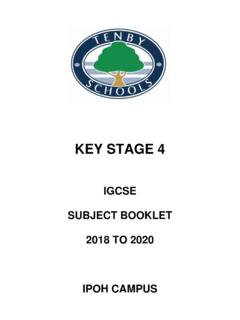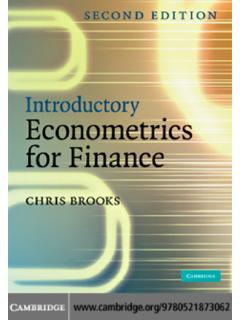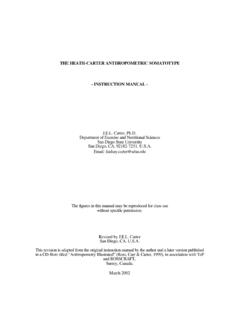Transcription of 9706 w13 ms 11 - Ultimate resource for cambridge …
1 cambridge international EXAMINATIONS GCE Advanced Subsidiary Level and GCE Advanced Level MARK SCHEME for the October/November 2013 series 9706 ACCOUNTING 9706/11 Paper 1 (Multiple Choice Core), maximum raw mark 30 Mark schemes should be read in conjunction with the question paper and the Principal Examiner Report for Teachers. cambridge will not enter into discussions about these mark schemes. cambridge is publishing the mark schemes for the October/November 2013 series for most IGCSE, GCE Advanced Level and Advanced Subsidiary Level components and some Ordinary Level components.
2 Page 2 Mark Scheme Syllabus Paper GCE AS/A LEVEL October/November 2013 9706 11 cambridge international Examinations 2013 Question Number Key Question Number Key 1 D 16 D 2 C 17 B 3 C 18 B 4 B 19 A 5 C 20 B 6 B 21 C 7 C 22 D 8 C 23 D 9 C 24 C 10 A 25 B 11 A 26 A 12 B 27 B 13 B 28 A 14 C 29 A 15 A 30 D cambridge international EXAMINATIONS GCE Advanced Subsidiary Level and GCE Advanced Level MARK SCHEME for the October/November 2013 series 9706 ACCOUNTING 9706/12 Paper 1 (Multiple Choice Core), maximum raw mark 30 Mark schemes should be read in conjunction with the question paper and the Principal Examiner Report for Teachers.
3 cambridge will not enter into discussions about these mark schemes. cambridge is publishing the mark schemes for the October/November 2013 series for most IGCSE, GCE Advanced Level and Advanced Subsidiary Level components and some Ordinary Level components. Page 2 Mark Scheme Syllabus Paper GCE AS/A LEVEL October/November 2013 9706 12 cambridge international Examinations 2013 Question Number Key Question Number Key 1 C 16 C 2 D 17 B 3 B 18 B 4 C 19 B 5 A 20 C 6 B 21 D 7 B 22 A 8 C 23 A 9 C 24 B 10 B 25 C 11 B 26 B 12 C 27 D 13 C 28
4 A 14 B 29 D 15 A 30 B cambridge international EXAMINATIONS GCE Advanced Subsidiary Level and GCE Advanced Level MARK SCHEME for the October/November 2013 series 9706 ACCOUNTING 9706/13 Paper 1 (Multiple Choice Core), maximum raw mark 30 Mark schemes should be read in conjunction with the question paper and the Principal Examiner Report for Teachers. cambridge will not enter into discussions about these mark schemes. cambridge is publishing the mark schemes for the October/November 2013 series for most IGCSE, GCE Advanced Level and Advanced Subsidiary Level components and some Ordinary Level components.
5 Page 2 Mark Scheme Syllabus Paper GCE AS/A LEVEL October/November 2013 9706 13 cambridge international Examinations 2013 Question Number Key Question Number Key 1 A 16 B 2 C 17 A 3 B 18 D 4 D 19 A 5 C 20 D 6 C 21 A 7 B 22 A 8 A 23 C 9 B 24 D 10 B 25 C 11 A 26 C 12 A 27 B 13 D 28 A 14 A 29 A 15 B 30 B cambridge international EXAMINATIONS GCE Advanced Subsidiary Level and GCE Advanced Level MARK SCHEME for the October/November 2013 series 9706 ACCOUNTING 9706/21 Paper 2 (Structured Questions Core), maximum raw mark 90 This mark scheme is published as an aid to teachers and candidates, to indicate the requirements of the examination.
6 It shows the basis on which Examiners were instructed to award marks . It does not indicate the details of the discussions that took place at an Examiners meeting before marking began, which would have considered the acceptability of alternative answers. Mark schemes should be read in conjunction with the question paper and the Principal Examiner Report for Teachers. cambridge will not enter into discussions about these mark schemes. cambridge is publishing the mark schemes for the October/November 2013 series for most IGCSE, GCE Advanced Level and Advanced Subsidiary Level components and some Ordinary Level components.
7 Page 2 Mark Scheme Syllabus Paper GCE AS/A LEVEL October/November 2013 9706 21 cambridge international Examinations 2013 1 (a) (i) Booksellers Limited Income statement for the year ended 31 December 2012 $000 $000 Gross profit for the year 415 Reduction in provision for bad debts 2(2) 417 Less expenses Wages 127 + 23 150 (2) Rent 44 8 36 (2) Heating and Lighting 15 Motor expenses 50 Office expenses 19 Insurance 15 Discount allowed 2 Other expenses 53 Debenture interest 1 (1) Bad debts 5 (1) Depreciation Motor vehicles 22(1) Shop fittings 3(2) Office fittings 3(1) 28 374 Retained profit for the year 43 Reduction in provision: (45 5) = 40 (1) 5% (1) = 2.
8 4 2 = 2 Depreciation shop fittings: (42 12) = 30 (1) 10% (1) = 3 [12] (ii) Calculation of retained earnings at 31 December 2012 $000 Retained profit for the year 43 Add retained profit b/f 26 (1) Retained profit at 31 December 2012 69 (1of) [2] Page 3 Mark Scheme Syllabus Paper GCE AS/A LEVEL October/November 2013 9706 21 cambridge international Examinations 2013 (b) Booksellers Ltd Statement of Financial Position at 31 December 2012 $000s $000s $000s Non-current assets Cost Depreciation Net book value Motor vehicles 176 68 108 Shop fittings 42 15 27 Office fittings 25 6 19(1) Goodwill 44 198(1of) Current assets Inventory 37 Trade receivables 40 Less provision for doubtful receivables 2 38 (1of) Other receivables 8 (1)
9 Bank 37 120 Current liabilities Trade payables 15 Other payables {23 (1) + 1 (1)} 24 39 Net current assets 81 Non-current liabilities 5% debentures 20(1) 259 Equity Ordinary share capital 190 Retained earnings 69(1of) 259 [8] (c) (i) Ordinary shares; Preference shares; Debentures; Long term loans; Factoring; Disposal of non-current assets no longer used. (1 mark each for any two) [2] (ii) Ordinary Shares: Advantages: They company does not have to pay a dividend if profits are low.
10 Dividends vary with profits. Disadvantages: Ordinary shareholders have a vote at annual general meetings. In a private company they can change the balance of control. Preference Shares: Advantages: The shareholders have no right to vote at AGM. The dividends are fixed. Disadvantages: Low or no profits, dividends may have to be paid or provided. Debentures/Long term loans: Advantages: Fixed rates of interest, repayment date known. Disadvantages: Interest needs to be paid even if no profit made, security may be required by the lender. (2 3 marks to max 6) [6] [Total: 30] Page 4 Mark Scheme Syllabus Paper GCE AS/A LEVEL October/November 2013 9706 21 cambridge international Examinations 2013 2 (a) Gross profit ratio = 1100 Sales NetProfit Gross It tests the profitability of sales.

